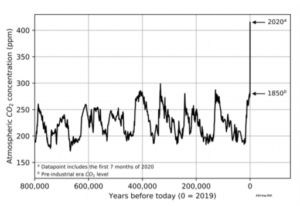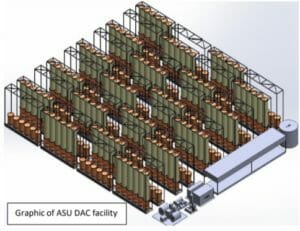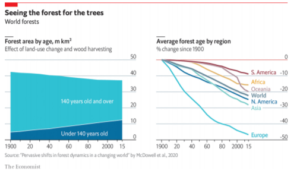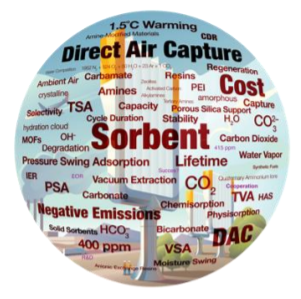“Yes, the laws of thermodynamics cannot be circumvented. One must pay the energy cost to recover the waste CO2 we produced. In short, we skimped on some of the cost while consuming energy in the past, and now we will have to pay it back. Cleaning up will not be free, but it will not break the bank either.” Dr. K S Lackner March, 2019
Statement of the Problem:
The world’s energy infrastructure is largely built around combustion of fossil carbon. Carbon, liberated from underground, combusted and released as carbon dioxide into the atmosphere where it is the dominant driver of climate change.
The facts are clear. Scientific measurement tells us the earth is heating up. There is some minor disagreement as to the speed of the change, but let’s get real, CO2 and related greenhouse gases are warming the world at an ever-accelerating pace. The CO2 concentration in the air is now 415+ ppm (parts per million) vs. the ~280 ppm it was during the warm periods of the least one million years; during the ice ages it would be expected to drop to 180 ppm. If we continue on the current path, we reach 500 ppm before 2050, which translates to a much hotter world. The change started gradually, which has allowed us to put off dealing with the cause. However, with today’s higher temperatures, stronger storms, lower crop yields and rising water the procrastination needs to end.
1. Can we tackle the problem?
This paper takes a look at how climate change might be “fixed”, including through the capture of CO2 which is our focus at the Center for Negative Carbon Emissions at Arizona State University. The discussion is intentionally centered on the release of fossil carbon. This is not to ignore or diminish the host of other greenhouse gases impacting climate, but to keep the discussion on the dominant and most damaging player – CO2. The strategy and tactics required to bring greenhouse gas releases under control will be one of the consuming international challenges of the 21st century. Yet, two decades into this new century, we have yet to determine the structure and technologies that will lead to a structured reversal.
We are now experiencing increased global temperatures contributing to enhanced storms, increased rainfall, melting glaciers, droughts, fires, etc. Even more concerning, we are on a path that will raise temperatures above 2 degrees C sometime after 2030, and probably above 3 degrees C shortly after 2050. Predictions depend upon the assumed measures taken to slow the increase in greenhouse gases. If we assume, for example, a serious commitment to decrease the production of CO2, an optimistic scenario has us implementing regulation and waste fees for CO2 by 2025. If many first and second world countries joined in that effort, we might reach peak CO2 between 2050 and 2060. At this point, we could start removing excess CO2 from the atmosphere and, possibly by 2100, return to levels last seen in the middle of the 20th century. No part of this optimistic scenario is possible without the removal of CO2 through bio-capture (trees) and mechanical direct air capture.
This scenario assumes that North America, Europe, and most of Asia spend trillions of dollars to reduce CO2 emissions and that we have figured out how to reduce CO2 output while maintaining a strong world economy. Even so, the results would not be all “strawberries and cream.” Many areas would have been abandoned because of flooding or drought, leading to mass population migrations. An October 2019 study published in Nature Communications, postulated that by the year 2050, 150 million will be under the water line during high tide and 300 million will live in zones with flooding every year. People will also suffer serious health problems and longevity would be impacted. Food production would be affected. The number and complexity of the variables in 21st century scenario is staggering with multiple negative impacts that affect millions of people. Life as we know it will be inexorably altered. And this is permanent change, once melted, the ice will not re-form.
Note: ppm = parts per million. In May 2019 Scripps recorded CO2 readings of 415.7. For tens of thousands of years CO2 remained in the mid 200’s; at over 400 we are at a level that we can with certainty state has not occurred in millions of years. And the rate of increase per year is exceeding past projections.
2. Climate:
“We live in a world of ever-growing concentration of greenhouse gases which, without remit, will inexorably threaten the eco system we depend on. Society must accept that human activity has led to the carbon that enters the atmosphere and the oceans; and that the net addition to this system will persist for at least hundreds of years.” Dr. Klaus Lackner, ASU/CNCE.
The extensive exploitation of fossil carbon resources, which began with the industrial revolution in the 1800s, has made carbon dioxide the dominant anthropogenic greenhouse gas.
Since industrialization, the carbon dioxide level in the earth´s atmosphere has risen by nearly 50%, saddling us with excess CO2 in the air and acidification of the ocean. Carbon dioxide pollution has altered the ecological balance of the world and negatively impacts economic productivity, food security, property values, health, and production.
To stop climate change, we must first stabilize and then reduce the CO2 level in the air. This means a transition to net zero CO2 emissions, followed by net negative CO2 emissions brought about by carbon capture and sequestration. The planet will continue heating, well beyond current temperatures even after we have stopped carbon waste production. Carbon dioxide pollution is a stockpile problem, not a flow problem. About half the released CO2 on the planet will persist in the atmosphere for hundreds of years. Stabilizing the CO2 in our atmosphere requires a stop to dumping fossil carbon into the environment. This will be possible if we commit to reducing CO2 output and capturing what is released.
The widening gap between where we are today and where we need to be underlines the urgency to change what is rapidly becoming an untenable situation. Instead of skepticism, we need collective mobilization to attack this pressing problem. Removing 1 ppm of CO2 from the air requires the removal of 4 Gt of carbon, which is equivalent to 15 Gt of CO2. A 100 ppm reduction requires the removal of roughly 1500 Gt of CO2. This is more CO2 than has been emitted in the 20th century. (Note: 1 Gt, or gigaton is equal to one billion metric tons. We release about 40 Gt of CO2 into the air each year). It will take many different actions to mitigate the changes that are coming. Later in this paper, we will focus on what we at the ASU Center for Negative Emissions are doing.
Currently, there are roughly 140 ppm excess CO2 in the air. We need to get at least 100ppm of that back. If it takes us 50 years to stop emissions, and we slow down at a constant rate, the world would add another 60 to 65 ppm raising the excess in the atmosphere to roughly 200ppm. In all likelihood, however, because we are still increasing emissions and are not yet scaling back that number will climb higher. Realistically, we may have to extract on the order of 150 to 200 ppm from the atmosphere.
3. Constructing a solution
Once we view CO2 emissions as a waste management problem, excess CO2 becomes a waste reduction and waste cleanup challenge. Both of these tasks require capture and disposal technologies as well as an industrial infrastructure to support a massive mitigation and clean-up. Viewed from this perspective, solutions require carbon removal technologies, among them the mechanical extraction of CO2 from the ambient air, known as Direct Air Capture (DAC).
Direct Air Capture (DAC) is the process of removing CO2 from air at any location, rather than removing it at the point of emission such as a smoke stack. DAC will not be a trivial undertaking. It needs large installations that capture, process and permanently dispose of the CO2. While air is available anywhere, DAC facilities need energy to run, lots of space, and access to permanent storage.
Solar energy, specifically, but renewable energy more generally, will become a preferred energy source for DAC, since it avoids additional carbon waste. In addition to supporting DAC these non-carbon energy sources can do more than supply electrons to the grid. For example, one might imagine a synthetic fuels industry that makes hydrocarbons from captured CO2 and hydrogen, produced from primary renewable energy resources. Under this scenario, existing pipelines would flow with “recycled” carbon in the form of CH4 or other carbon based fuels for use in existing energy infrastructures.
In the near term, all of these solutions turn on pricing carbon waste. Money will be the critical deciding factor in what action we take. Ultimately there will be a price on dumping carbon waste into the air and oceans. The cleanup of that carbon (CO2) waste may take a number of forms and how much each solution costs will be critical in the decision process. The waste management paradigm makes a waste fee understandable and desirable. This fee reflects the cost of capturing CO2 from sources of production or by removing CO2 from the atmosphere and the cost of storing it. Today, the cost of capture is high, but viewing carbon as a waste by-product encourages the development of a market. Two forces are likely to converge: the first is the carbon fee, which introduces market forces to encourage clean-up; the second is a research and development program that brings the cost of air capture first below $200/ton, hopefully well below $100/t. Longer term, the waste management fee will be determined by the market, at the start it will probably need to be set and slowly adjusted.
Going forward, markets will determine the fee, so long as the waste fee is sufficient for capture and sequestration. Transactional details must still be determined such as how does the waste fee devolve to pay for capture, how do we use the fee to stop emissions by 2050, and if we can stop the rise in CO2, how do we move the needle back to ~300 ppm? In addition to a waste fee, additional regulations governing the emission of CO2 and other pollutants will likely be necessary. Some waste producers will drag their feet, and, in those cases, regulation might be the most effective means to encourage a timely response. Whether we use a waste fee or regulations the effort ought to be based on economic incentive. We know what to do – reduce carbon extraction, burn less carbon, and capture & permanently store what has been released down to pre 1950 levels.
4. Carbon Capture
The expansion of renewable resources, such as biomass, is an obvious possibility for harvesting carbon from the atmosphere. Biomass (trees and plants) ought to be a significant part of the solution but, unfortunately, biomass does not sufficiently scale to match the size of the challenge. And of course, we are currently reducing biomass, thus making the problem worse. Plants are effective at carbon capture; but they are not highly efficient, and have a relatively short life cycle, after which a good deal of carbon is returned to the atmosphere. Calculations indicate that most of the arable land on earth would have to be cultivated for carbon capture with biomass, if this were to be the preferred solution to CO2 waste. That said, forests present an attractive option for storage. Hopefully, an increased emphasis on planting long-life trees in open areas, and preserving existing forests, will become part of the decarbonization campaign.
Mechanical capture such as DAC will also need to be utilized. To close the anthropogenic carbon cycle and avoid a further increase in CO2 content in the atmosphere, we will need to rely on multiple efficient solutions. Negative emissions, such as the one Arizona State University (ASU) is working on, offer significant promise for large-scale capture. They reduce the CO2 concentration in the air by removing carbon from the environment with subsequent sequestration. ASU is one of a number of research universities and private companies designing carbon negative CO2 devices. It has become clear that negative emissions (or capture and permanent storage) are a necessary requirement to limit global warming.
The Center for Negative Carbon Emissions at Arizona State University, currently the leading university in Direct Air Capture research, has developed a passive CO2 capture design that shows promise for “low cost” removal of CO2 from the atmosphere at a massive scale. The ASU TiburioTM design is based on experience gained through extensive lab testing and the operation of our early field prototype. ASU’s Tiburio has an efficient, elegant design that promises low capital cost, efficient assembly, minimal maintenance, and low-cost operation. Captured CO2 becomes a product stream for multiple applications, including sequestration, agriculture, fuel recycle, and other uses. The captured CO2 from the Tiburio will be concentrated, which will provide for a large range of applications including storage. We envision grouping Tiburios as clusters and integrating them with a compression and purification unit to produce CO2 in varying concentrations, generally in the 90+ percent range. Minimizing emissions will not be sufficient to stabilize climate below 1.5 or even 2°C. The most plausible way out of this looming catastrophe is to combine emission reductions with “negative-emission” or “drawdown” technologies, such as the Tiburio.
5. Reduction and Mitigation to move toward turn-around
Removal is only one part of the answer, although admittedly the portion of the equation we at ASU have focused on. Reduction and mitigation will be at least as significant as removal.
Reduce
We will need to make adjustments to correct our CO2 waste imbalance. Each modification should be evaluated with the negatives balanced against the positives. All changes would need to be coordinated among many nations for any hope of success. Not every country will join the effort. Some will be impacted by climate change to such a degree that they won’t have the wherewithal to participate. Others will seize this moment to improve their own economic lot at the expense of others. Those nations that are willing to move forward will need to accept that they will assume an oversized burden. In time, forced compliance may be required for the others.
Mitigate
We have already passed the tipping point where we cannot reduce and remove carbon fast enough to avoid serious consequences. Therefore, we must have a strategy to mitigate this massive problem.
In the best case, we achieve a balance between output of CO2 and removal by the 2050’s. This will require a massive reduction in CO2 emissions to the atmosphere along with a World War Two-level ramping up of production of carbon capture equipment that removes millions of tons of CO2 from the environment every year. When net emissions drop to zero, we will need to follow-up with continued removal and reduction until we have driven the amounts in the atmosphere back to within the 300ppm range. Hypothetically, we might achieve that goal early in the next century. The conversion to less carbon burning and more carbon capture will create disruption, but it is a way to a more prosperous future, and to fixing a historic mistake.
6. When to start and how?
Ideally, we would begin immediately because the longer we delay, the more carbon accumulates with its attendant problems and irreversible effects. The timing and the method of introducing change will impact our chances for success, the sooner we start and the better the options we select, the better the outcome. However, we are unlikely to begin now. While many grasp the problem intellectually, few have the emotional fear that should attend the change our climate is experiencing. Our theory is that a sizable effort will be undertaken only when the intellectual comprehension is combined with an emotional drive. Things may need to get worse before an emotional response is engaged, although we hope that the application of solutions will begin sooner.
At some point, in the not too distant future, a fee for waste carbon will be established. Without a carbon waste price, the energy market is distorted because the price of fossil fuels does not fully reflect the physical and social costs of its use. A waste carbon fee would change that. The price would affect consumption patterns and provide the funds to pay for carbon removal. It can be used to remove CO2 that has been emitted in the past, or cancel out those uses that are not easily eliminated – emissions from air planes, ships, cement and steel production. Properly structured, the waste fee (possibly supported by tariffs and some targeted regulation) would encourage those that continue to produce CO2 emissions to pay for its removal – revenue collected from waste carbon fees would fund the removal of past CO2 waste in the atmosphere and support new research for removal and avoidance technologies. The changes we envision and believe are necessary will increase the cost of carbon related products, but eventually we must pay for the consequences of these products. Consequences are the balance side of the equation.
This will cost a good deal of money. And while none of us can delineate the amount with any specificity we can be confident that the longer we wait the higher the overall cost. We need to collectively acknowledge that our economic gains associated with consumption of carbon were, at the time of consumption, discounted by the absence of waste recovery. Now we need to pay for that oversight.
7. Getting to global action
Most countries accept the urgency to mitigate the effects of climate change, yet so far approaches to carbon dioxide emission reductions have not been effective. In the future as countries adopt waste fees, regulation, and mitigation some countries will not join in attempting to get a “free ride”. Countries getting a free ride can be identified, and a formula can be designed to calculate trade sanctions to incentivize carbon emissions reductions.
We propose a simple methodology based on three economic metrics: GDP per capita, carbon intensity defined as emissions per unit of purchasing parity-adjusted GDP, and the year-toyear change in carbon intensity. These metrics can be used to evaluate the appropriateness of a country’s emission reductions in comparison to other countries. This methodology would identify countries that heavily contribute to climate change and do the least to fix it. The formula does not penalize economic growth or attack poor countries with more pressing poverty issues.
A metrics approach provides the basis for a generally-accepted rationale for trade sanctions, even in the absence of an international agreement. Though rarely used, and perhaps difficult to implement, trade sanctions based on environmental standards appear to be a rational solution to encouraging the non-participants. The intent is not to analyze the legal and political intricacies of trans-border carbon tariffs or border adjustment fees, but rather to provide a transparent and simple methodology for identifying free-riders.
8. Impacts Energy makes modern life possible
The 19th century transition from a human/animal source of energy to machine based energy transformed our life-span and health profile. Our two century old energy culture supports creative, productive humans with leisure time unheard of prior to 1800. The stability of the energy system is vital to our well-being and critical to our ability to attack the vast amounts of waste carbon we have placed in the atmosphere. Maintaining energy for economic growth, while meeting the challenges of the warming climate, will become even more important as we work toward turn-around.
Despite our best efforts, disruption will be unavoidable. Some industries and geographic areas will be seriously impacted. The sooner society accepts that combating climate damage is a must, the better the opportunity for adaptive approaches, rather than more draconian measures. During the transition we must remain committed to ensuring stable economic growth. A strong economy is a must if we are going to afford the required changes, new devices, and disruptions. We will need a combination of reduction, capture, mitigation and energy source transfer – and be able to pay for it.
Many of the current climate caused impacts are going to be permanent. We can grab CO2 out of the air, reducing the amount in the atmosphere to pre-industrial levels which will stabilize and eventually reduce average temperatures. But we cannot recreate the lost glaciers or the melted permafrost. Coastlines and islands lost to sea rise will not raise out of the ocean. Nor will the Jet Stream and other shifts re-align back to their prior positions. We have caused damage that we cannot repair, now the challenge is to limit the unpredictable future damage. And we can do that, we are creating the tools that we already we have the knowledge to build. Time to take the jump and begin collecting our waste.
9. What will success look like?
Carbon capture is a very real new weapon in the battle against climate change. And, once we gain momentum, we will be able to push sustainable, renewable energy forward as well.
New energy systems must be carbon-neutral, embracing a waste management paradigm. There are very few energy resources that can operate sustainably on a global scale, currently demanding 18 Terawatt – year of primary energy, with a growth rate of nearly 2.5% annually. Three systems — solar energy, nuclear energy, and possibly captured fossil carbon with recycle and storage — can work in combination at such volumes. With photovoltaic energy costs dropping rapidly, we may be transitioning to a carbon neutral world already. However, we must dramatically speed up the process and also factor in the sequestration of CO2 emitted as a part of the transition.
It is now mandatory that the world clean up the mess it has already made and mop up what we are adding every year. It is impossible to avoid a serious overshoot in atmospheric CO2 concentration; we are too late for that. Since the world has entered an overshoot scenario, it is imperative that we return as quickly as possible to safe levels. That goal demands large amounts of negative emissions coupled with large reductions in CO2 production.
Conclusion
To meet the challenge of climate change, we must manage the massive CO2 waste stream, as we manage urban garbage or sewage. We have passed the point where simply reducing carbon dioxide emissions will allow us to meet our climate goals. These goals can only be achieved by removing excess carbon from the environment, capturing and safely disposing of the carbon waste that has been produced, and continues to be dumped into our atmosphere. Our waste management problem is staggering. We must collect and dispose of more carbon than was emitted during the entire 20th century.
Fortunately, a number of permanent storage technologies are proven effective. Air capture with carbon disposal makes it possible to rethink carbon dioxide as a waste with a solution. We must couple this with an even larger mitigation effort focused on solar and other nocarbon based energy sources. Eventually, as the world approaches zero carbon waste, air capture can transition into a new role that supports a circular carbon economy. Solar energy, water, and carbon dioxide from the air can be used to manufacture synthetic fuels for airplanes, ships, and trucks, which can eliminate the need for fossil fuels.
Recycling is a desirable waste management outcome. It moves waste into product (fuel, plastics, etc.) and back to waste, which avoids introducing new carbon from new underground sources. The economics require that waste management extracts a fee. When natural gas, petroleum, and coal are required to pay a carbon tipping fee, carbon recycling will become economically appealing.
The goal is not to eliminate energy or all carbon applications but to assist in a dramatic, but smooth energy transition. Over time, fossil fuels can be phased out without touching the core of the energy system. The cost of lower efficiency and the intermittency problem of renewables can be eliminated with recycled carbon liquids and gas. In time, markets will optimize what fraction of the energy goes straight to the grid, into batteries, into hydrogen, and into carbonaceous fuels. There is a viable (albeit future) energy infrastructure that runs on renewable input, and uses PV exclusively to feed an energy infrastructure that is not all that different from today’s. In this future, fuels will no longer come out of the ground, but are pulled from large solar and other renewable installations that are combined with DAC and fuel synthesis.
A future freed from in fossil carbon could be healthier, sustainable, and provide an even richer human experience than the one gained through the combustion of fossil carbon. We might be introducing a world with even more explosive creativity and human benefits.
“Let us have faith that right makes might, and in that faith let us, to the end, dare to do our duty as we understand it” A. Lincoln, The Cooper Union Address, February 1860






